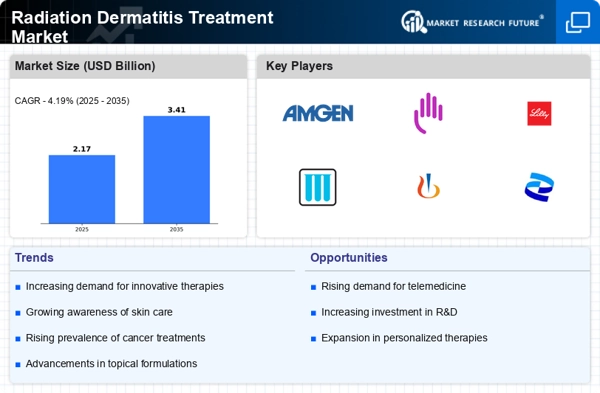Growing Awareness and Education
There is a notable increase in awareness regarding radiation dermatitis among healthcare professionals and patients alike. Educational initiatives aimed at informing both groups about the risks associated with radiation therapy and the importance of early intervention are gaining traction. This heightened awareness is expected to positively influence the Radiation Dermatitis Treatment Market, as patients are more likely to seek treatment options when they understand the potential complications of their therapy. Furthermore, healthcare providers are increasingly incorporating skin care protocols into their treatment plans, which may lead to a rise in the adoption of specialized products designed to manage radiation-induced skin reactions.
Advancements in Treatment Modalities
Innovations in the field of dermatology and oncology are contributing to the evolution of the Radiation Dermatitis Treatment Market. New treatment modalities, including biologics and advanced topical agents, are being developed to enhance patient outcomes and minimize side effects. For instance, the introduction of novel wound care products and skin protectants has shown promise in reducing the severity of radiation dermatitis. The market is witnessing a shift towards more effective and targeted therapies, which may lead to improved patient compliance and satisfaction. As these advancements continue to emerge, they are likely to stimulate growth within the market, attracting both healthcare providers and patients seeking better management options.
Rising Incidence of Cancer Treatments
The increasing prevalence of cancer worldwide has led to a corresponding rise in the number of patients undergoing radiation therapy. This trend is likely to drive the Radiation Dermatitis Treatment Market, as radiation therapy is a common treatment modality that often results in skin complications such as dermatitis. According to recent statistics, nearly 50% of cancer patients receiving radiation therapy experience some form of skin reaction, which underscores the necessity for effective treatment options. As the number of cancer diagnoses continues to grow, the demand for specialized products and therapies to manage radiation-induced skin conditions is expected to expand significantly, thereby propelling the market forward.
Regulatory Support for Innovative Treatments
Regulatory bodies are increasingly supportive of the development and approval of innovative treatments for radiation dermatitis. This trend is likely to foster growth within the Radiation Dermatitis Treatment Market, as streamlined approval processes can expedite the availability of new therapies. For example, the introduction of fast-track designations for promising treatments can encourage pharmaceutical companies to invest in research and development. As a result, the market may see a surge in novel products that address the needs of patients experiencing radiation-induced skin complications, ultimately enhancing treatment options and improving patient care.
Increasing Investment in Healthcare Infrastructure
The ongoing investment in healthcare infrastructure, particularly in oncology departments, is expected to bolster the Radiation Dermatitis Treatment Market. Enhanced facilities and resources allow for better patient management and the implementation of comprehensive care protocols, including skin care during radiation therapy. As healthcare systems expand and improve, the availability of specialized treatments for radiation dermatitis is likely to increase. This investment not only supports the development of new therapies but also facilitates the training of healthcare professionals in managing skin complications, thereby promoting better patient outcomes and driving market growth.

















Leave a Comment